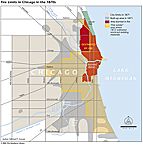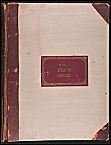| Entries |
| F |
|
Fire Limits
|

|

|
After the Great Chicago Fire of 1871, the fire limit was the focus of a conflict between elites demanding extension over the whole city and working-class homeowners, particularly German immigrants on the North Side, who depended on cheap construction techniques. The full-city extension was defeated in 1872 but enacted after another major fire in 1874.
Bibliography
Rosen, Christine Meisner.
The Limits of Power: Great Fires and the Process of City Growth in America.
1986.
Sawislak, Karen J.
Smoldering City: Chicagoans and the Great Fire, 1871–1874.
1996.
The Electronic Encyclopedia of Chicago © 2005 Chicago Historical Society.
The Encyclopedia of Chicago © 2004 The Newberry Library. All Rights Reserved. Portions are copyrighted by other institutions and individuals. Additional information on copyright and permissions.
The Encyclopedia of Chicago © 2004 The Newberry Library. All Rights Reserved. Portions are copyrighted by other institutions and individuals. Additional information on copyright and permissions.